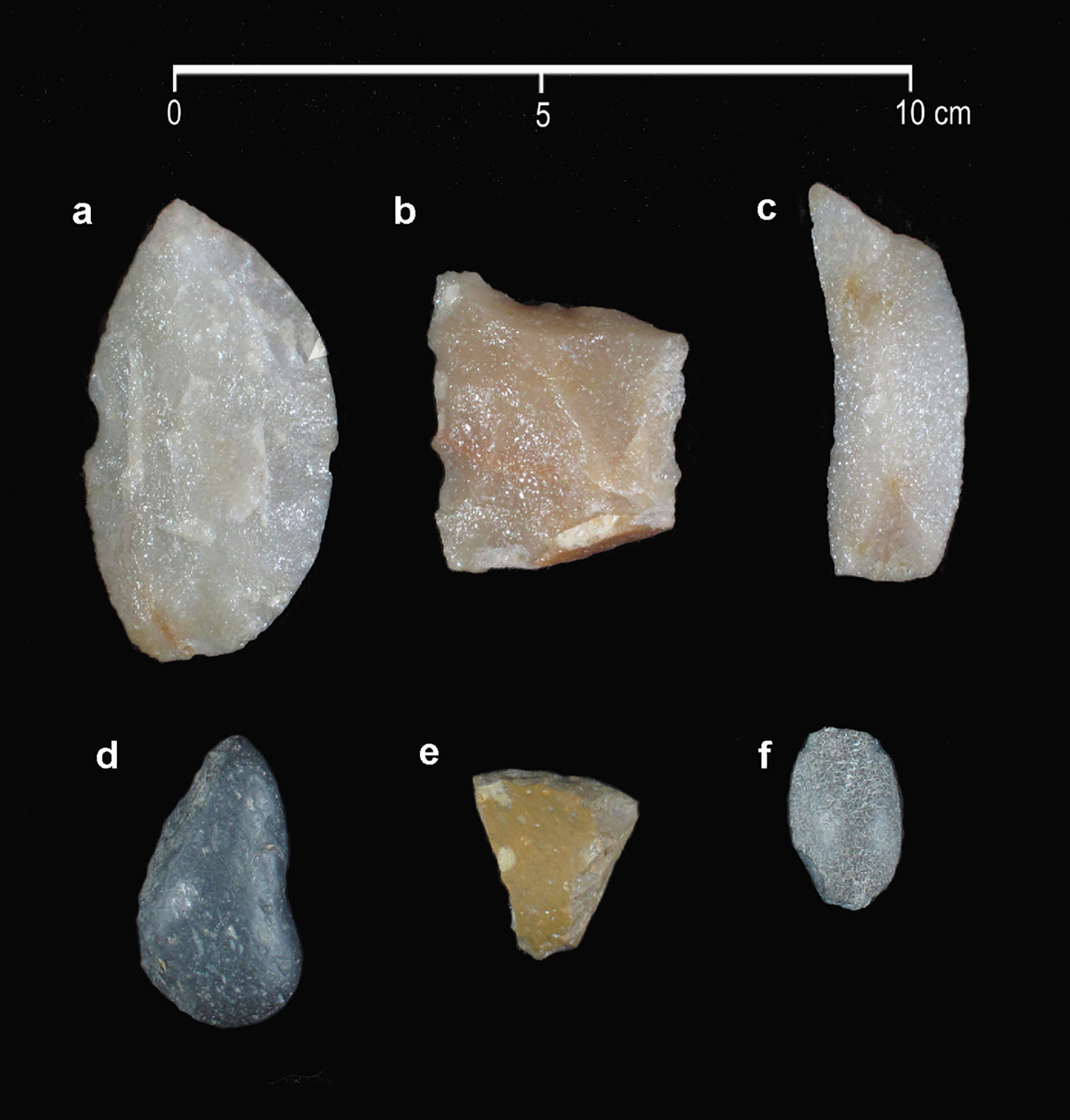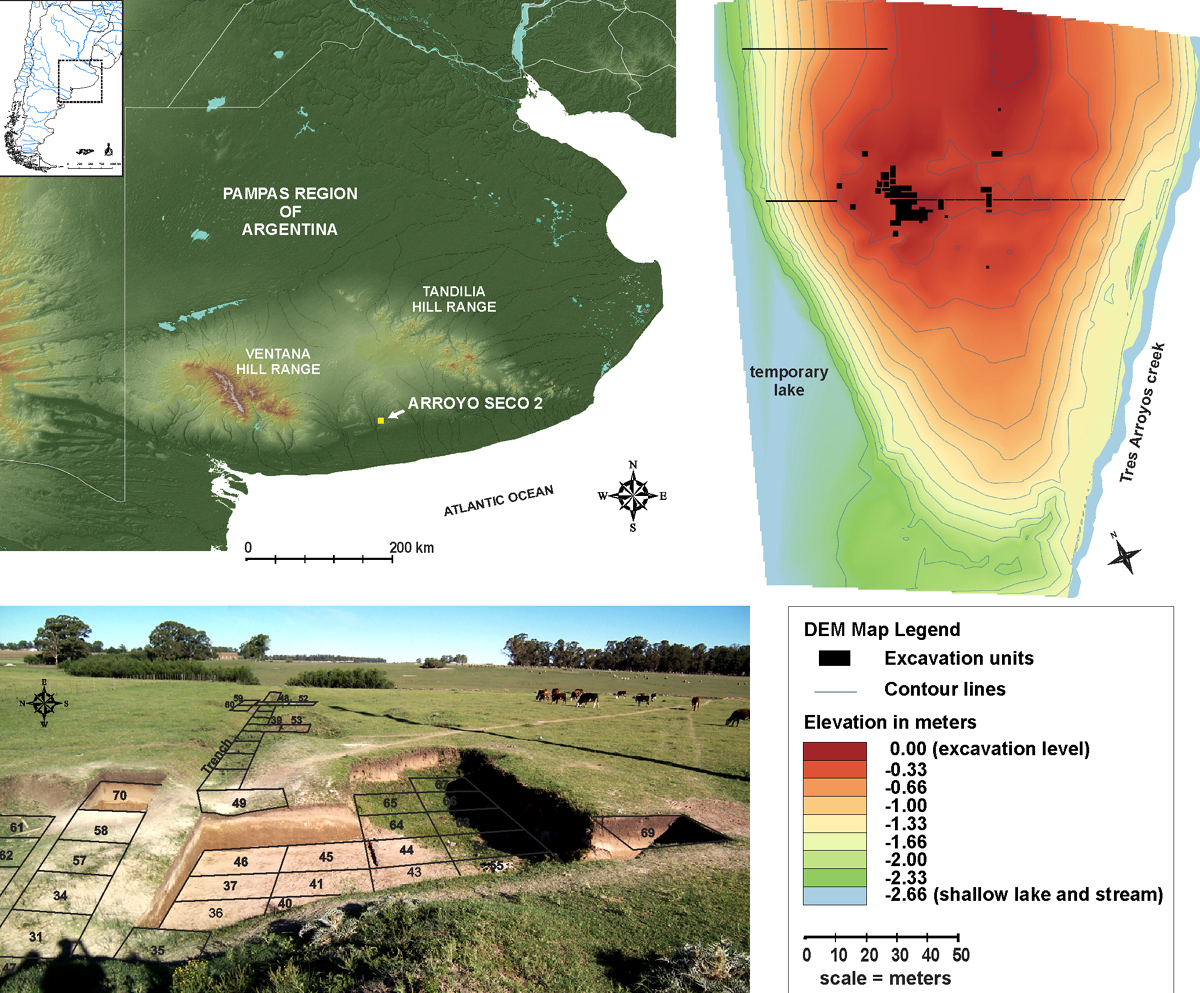


An article by Annalee Newitz on arstechnica - 14,000-year-old campsite in Argentina adds to an archaeological mystery - reports on 'the last people on Earth to colonise a continent without humans.'

Tools found at the Arroyo Seco 2 site in Argentina: (a) side scraper, quartzite; (b) retouched flake, quartzite; (c) retouched flake, quartzite; (d-e) scrapers made on coastal rounded cobbles; (f) bipolar cobble. Image: Gustavo G. Politis et al
Scientific evidence has been growing for over a decade that humans colonized the Americas thousands of years before the Clovis people. The Clovis, the early ancestors of today's Native Americans, left abundant evidence of their lives behind in the form of tools and graves.
What about the pre-Clovis humans, who may have arrived 17,000 to 14,000 years ago? The sources of evidence are at campsites where they processed animals during hunting trips. A fresh examination of one such campsite, a 14,000-year-old hunter's rest stop outside the city of Tres Arroyos in Argentina, may provide more answers.
14,000-year-old pre-Clovis campsite in #Argentina #archaeology #megafauna #PreClovis https://t.co/92yZxo43ic pic.twitter.com/2harLbWbnT
— Bradshaw Foundation (@BradshawFND) October 5, 2016
Images: Heinrich Harder & Robert Horsfall
Archaeologists are still uncertain how the pre-Clovis people arrived in the Americas. But given the climate at the end of the Ice Age, it is now thought that they would have come from Asia via a coastal route, frequently using boats for transport. That would explain why many pre-Clovis sites are on the coast, on islands, or on rivers that meet the ocean.
These early settlers were hunter-gatherers who used stone tools for a wide range of activities, including hunting, butchery, scraping hides, preparing food, and making other tools out of bone and wood. Such tools were relatively simple, made by using one stone to flake pieces off the other, thus creating sharp edges. At the Arroyo Seco 2 site, archaeologists - writing in PLoS One - have found more than 50 such tools made from materials like chert and quartzite (from a distant source), along with thousands of animal bone fragments that have been carbon dated to as early as 14,000 years ago. There are also over 20 human burials at the site, dated to a later period starting roughly 9,000 years ago.
The Arrival of Homo sapiens into the Southern Cone at 14,000 Years Ago
Gustavo G. Politis, Maria A. Gutierrez, Daniel J. Rafuse, Adriana Blasi
PLoS One September 28, 2016
Are the tools at the site 14,000 years old? Archaeologists infer some of this from carbon dates on the animal bones, which have been vigorously tested. However, the site's stratigraphy is difficult to read due to erosion - if a tool appears near a bone in a given layer, it may have come from later and been moved around by wind and water. To counter this, many of the early bones were broken by stone tools. A 14,000-year-old bone from Equus neogeus, an extinct American horse, bears distinct marks from a hammerstone.

Image: Gustavo G. Politis et al
Analysis of more than 600 bone fragments out of thousands found at the site revealed that a large amount of the meat came from now extinct animals; various extinct horse species were a major part of the pre-Clovis diet, as were other extinct mammals like giant ground sloths, camels, mammoths, and giant armadillos. When these people arrived in South America, they found a land that no human had ever colonized. Many of these species would have been easy to hunt. The absence of animal skulls, chests and pelvic bones suggests the hunters would have done an initial butchery then transported meat to the camp.
Of the extinct mammals that humans processed at Arroyo Seco, the most common seems to be horse. When people arrived in the Americas, it was full of at least two species of extinct horses. But by the time of the Inca and other great civilizations of South America, those animals were long gone. It wasn't until Europeans arrived with their steeds that the continent was once again populated with horses.
http://www.bradshawfoundation.com/
Commentby Bradshaw Foundation
Tuesday 21 March 2023
by Bradshaw Foundation
Tuesday 07 February 2023
by Bradshaw Foundation
Thursday 19 May 2022
by Bradshaw Foundation
Tuesday 19 October 2021
by Bradshaw Foundation
Friday 25 June 2021
by Bradshaw Foundation
Monday 09 November 2020
by Bradshaw Foundation
Tuesday 03 November 2020
by Bradshaw Foundation
Wednesday 28 October 2020
by Bradshaw Foundation
Tuesday 23 June 2020
by Bradshaw Foundation
Thursday 04 June 2020
by Bradshaw Foundation
Thursday 14 May 2020
by Bradshaw Foundation
Tuesday 12 May 2020
by Bradshaw Foundation
Wednesday 19 February 2020
by Bradshaw Foundation
Tuesday 21 January 2020
by Bradshaw Foundation
Monday 20 January 2020
by Bradshaw Foundation
Thursday 28 November 2019
by Bradshaw Foundation
Tuesday 21 March 2023
by Bradshaw Foundation
Tuesday 07 February 2023
by Bradshaw Foundation
Thursday 19 May 2022
by Bradshaw Foundation
Tuesday 19 October 2021
by Bradshaw Foundation
Friday 25 June 2021
by Bradshaw Foundation
Monday 09 November 2020
by Bradshaw Foundation
Tuesday 03 November 2020
by Bradshaw Foundation
Wednesday 28 October 2020
by Bradshaw Foundation
Tuesday 23 June 2020
by Bradshaw Foundation
Thursday 04 June 2020
by Bradshaw Foundation
Thursday 14 May 2020
by Bradshaw Foundation
Tuesday 12 May 2020
by Bradshaw Foundation
Wednesday 19 February 2020
by Bradshaw Foundation
Tuesday 21 January 2020
by Bradshaw Foundation
Monday 20 January 2020
by Bradshaw Foundation
Thursday 28 November 2019
Friend of the Foundation











